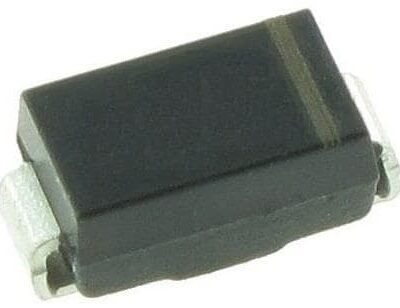MBRA340T3G
Part Number: MBRA340T3G
Manufacturer: onsemi
Description: Schottky Diodes & Rectifiers 3A 40V
Shipped from: Shenzhen/HK Warehouse
Stock Available: Check with us
ICRFQ.com - Electronic Components Distributor in China Since 2003

Part Number: MBRA340T3G
Manufacturer: onsemi
Description: Schottky Diodes & Rectifiers 3A 40V
Shipped from: Shenzhen/HK Warehouse
Stock Available: Check with us
| Datasheet | |
|---|---|
| Category | Discrete Semiconductor Products |
| Family | Diodes – Rectifiers – Single |
| Manufacturer | ON Semiconductor |
| Series | – |
| Packaging | Tape & Reel (TR) |
| Diode Type | Schottky |
| Voltage – DC Reverse (Vr) (Max) | 40V |
| Current – Average Rectified (Io) | 3A |
| Voltage – Forward (Vf) (Max) @ If | 450mV @ 3A |
| Speed | Fast Recovery =< 500ns, > 200mA (Io) |
| Reverse Recovery Time (trr) | – |
| Current – Reverse Leakage @ Vr | 300μA @ 40V |
| Capacitance @ Vr, F | – |
| Mounting Type | Surface Mount |
| Package / Case | DO-214AC, SMA |
| Supplier Device Package | SMA |
| Operating Temperature – Junction | -55°C ~ 150°C |
The MBRA340T3G from On Semiconductor is a Schottky power rectifier with a surface mount “J” bent lead configuration, and it comes in an SMA (CASE 403D-02) package. Construction is epitaxial, and the oxide passivated junction and metal contacts are stable. This component is designed for freewheeling, polarity protection, low voltage rectification, and space- and weight-sensitive applications.
Schottky barrier rectifiers are widely used in switching converters for power regulation, ESD protection, and microwave circuits. Both uses necessitate meeting specifications for maximum allowable current, voltage, and junction capacitance.
Switching Schottky diodes from forward to reverse bias allows DC to be routed across an inductor and out of a regulator circuit. Since a pulse width modulation signal drives the upstream switching power MOSFETs, the diode must have a low junction capacitance to switch and fully modulate between the two states at the same rate. The device’s voltage and current limits are also crucial; it must be able to function at the applied voltage without breaking down.
Schottky diodes provide dependable protection against some low-voltage or slow-moving transient occurrences. Take a look at the simplified circuit diagram that follows as an illustration. This configuration uses two Schottky diodes as pull-up components connected to a reverse-biased power rail. As a result of their low forward voltage drop, these diodes can clamp reverse bias currents to the ground from moderate to high-intensity ESD events. Placing the Schottky diode in parallel around the load in reverse bias will create the same effect and protect the driver circuit from damage should a back EMF surge event occur; this is a standard application in motor control or when driving large inductive loads. A gas discharge tube is a good choice if extremely high ESD protection is required.
Several features of the Schottky diode power rectifier make it a viable option in many contexts:
The low forward voltage drop offered by Schottky diode power rectifiers is a significant advantage in many applications. It reduces the power losses typically incurred in the rectifier and other diodes used within the power supply. The most common alternative, silicon diodes with a 0.6-0.7 volt turn-on voltage, is a standard component. Schottky diode rectifiers can save power because they only need 0.2 to 0.3 volts to turn on. However, it is necessary to remember that the material’s resistance will also introduce losses, and the voltage drop across the diode will increase with the current. In many cases, a Schottky diode rectifier will have significantly fewer failures than an equivalent silicon rectifier.
The Schottky diode rectifier is well-suited for use in switching regulator circuits due to its fast switching speeds, which allow for greater efficiency than is possible with other types of power rectifier diodes.
Although Schottky diode rectifiers have several benefits, there are a few things to keep in mind when designing them. The current circuit design should account for these.
The following are just a few considerations that should be made:
Due to its design, a Schottky diode rectifier can only handle a small amount of reverse voltage. In most cases, maximum values hover around 100 volts. If devices were produced with values higher than these, the forward voltages would increase and become comparable to or greater than those of equivalent silicon diodes for current practical levels.
The reverse leakage current of Schottky diode rectifiers is significantly higher than that of regular PN junction silicon diodes. Some designs might not be affected by this, but others might.
Schottky diode rectifiers typically have a temperature rating of 125 °C to 175 °C for their junctions, but this can vary depending on the manufacturer. In contrast, silicon diode rectifiers operate at about 200 degrees Celsius.
When used in high-power applications, the Schottky diode’s relatively tiny forward voltage drop can lead to significant heat generation. Keep this in mind, and don’t just assume heatsinks aren’t needed because the voltage drop is smaller. The junction can only tolerate lower temperatures than equivalent silicon diodes.
Schottky diode rectifiers like ON Semiconductor’s MBRA340T3G make converting AC to DC straightforward. Tape and reel packaging will be used to transport and install this part safely. Only one setup is used to create it. The temperature range that this rectifier can work in is from -55 degrees to 150 degrees Celsius. It has a maximum forward current of 3 A and can withstand a peak non-repetitive surge current of 100 A.
If you need information or want to order MBRA340T3G, contact us here at ICRFQ, your leading electronic component supplier in China, and we will ensure you get the best product at the best price.
WhatsApp us